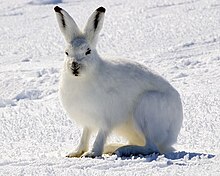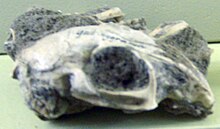Leporidae
| Rabbits and hares[1] Temporal range: 53–0 Ma PreЄ Є O S D C P T J K Pg N Eocene-Holocene | |
|---|---|
 | |
Arctic hare (Lepus arcticus) | |
Scientific classification | |
| Kingdom: | Animalia |
| Phylum: | Chordata |
| Class: | Mammalia |
| Order: | Lagomorpha |
| Family: | Leporidae Fischer de Waldheim, 1817 |
| Genera | |
Pentalagus | |
Leporidae is the family of rabbits and hares, containing over 60 species of extant mammals in all. The Latin word Leporidae means "those that resemble lepus" (hare). Together with the pikas, the Leporidae constitute the mammalian order Lagomorpha. Leporidae differ from pikas in that they have short, furry tails and elongated ears and hind legs.
The common name "rabbit" usually applies to all genera in the family except Lepus, while members of Lepus (almost half the species) usually are called hares. Like most common names however, the distinction does not match current taxonomy completely; jackrabbits are members of Lepus, and members of the genera Pronolagus and Caprolagus sometimes are called hares.
Various countries across all continents except Antarctica and Australia have indigenous species of Leporidae. Furthermore, rabbits, most significantly the European rabbit, Oryctolagus cuniculus, also have been introduced to most of Oceania and to many other islands, where they pose serious ecological and commercial threats.
Contents
1 Characteristics
2 Reproduction
3 Evolution
4 Classification
5 Predation
6 See also
7 References
Characteristics
Leporids are small to moderately sized mammals, adapted for rapid movement. They have long hind legs, with four toes on each foot, and shorter fore legs, with five toes each. The soles of their feet are hairy, to improve grip while running, and they have strong claws on all of their toes. Leporids also have distinctive, elongated and mobile ears, and they have an excellent sense of hearing. Their eyes are large, and their night vision is good, reflecting their primarily nocturnal or crepuscular mode of living.[2]
Leporids range in size from the pygmy rabbit (Brachylagus idahoensis), with a head and body length of 25–29 cm, and a weight of around 300 grams, to the European hare (Lepus europaeus), which is 50–76 cm in head-body length, and weighs from 2.5 to 5 kilograms.
Both rabbits and hares are almost exclusively herbivorous (with exceptions among the members of Lepus),[3][4] feeding primarily on grasses and herbs, although they also eat leaves, fruit, and seeds of various kinds. They are coprophagous, as they pass food through their digestive systems twice, first expelling it as soft green feces, called cecotropes, which they then reingest, eventually producing hard, dark fecal pellets. Like rodents, they have powerful front incisor teeth, but they also have a smaller second pair of incisors to either side of the main teeth in the upper jaw, and the structure is different from that of rodent incisors. Also like rodents, leporids lack any canine teeth, but they do have more cheek teeth than rodents do. Their jaws also contain a large diastema. The dental formula of most, though not all, leporids is: 2.0.3.31.0.2.3
They have adapted to a remarkable range of habitats, from desert to tundra, forests, mountains, and swampland. Rabbits generally dig permanent burrows for shelter, the exact form of which varies between species. In contrast, hares rarely dig shelters of any kind, and their bodies are more suited to fast running than to burrowing.[2]
The gestation period in leporids varies from around 28 to 50 days, and is generally longer in the hares. This is in part because young hares, or leverets, are born fully developed, with fur and open eyes, while rabbit kits are naked and blind at birth, having the security of the burrow to protect them.[2] Leporids can have several litters a year, which can cause their population to expand dramatically in a short time when resources are plentiful.
Reproduction
Leporids are typically polygynandrous, and have highly developed social systems. Their social hierarchies determine which males mate when the females go into estrus, which happens throughout the year. Gestation periods are variable, but in general, higher latitudes correspond to shorter gestation periods.[5] Moreover, the gestation time and litter size correspond to predation rates as well. Species nesting below ground tend to have lower predation rates and have larger litters.[6]
Evolution

Serengetilagus praecapensis skull, Naturkundemuseum, Berlin
The oldest known leporid species date from the late Eocene, by which time the family was already present in both North America and Asia. Over the course of their evolution, this group has become increasingly adapted to lives of fast running and leaping. For example, Palaeolagus, an extinct rabbit from the Oligocene of North America, had shorter hind legs than modern forms (indicating it ran rather than hopped) though it was in most other respects quite rabbit-like.[7] Two as yet unnamed fossil finds—dated ~48 Ma (from China) and ~53 Ma (India)—while primitive, display the characteristic leporid ankle, thus pushing the divergence of Ochotonidae and Leporidae yet further into the past.[8]
The cladogram is from Kraatz et al, 2015, based on nuclear and mitochondrial gene analysis.[9]
.mw-parser-output table.clade{border-spacing:0;margin:0;font-size:100%;line-height:100%;border-collapse:separate;width:auto}.mw-parser-output table.clade table.clade{width:100%}.mw-parser-output table.clade td{border:0;padding:0;vertical-align:middle;text-align:center}.mw-parser-output table.clade td.clade-label{width:0.8em;border:0;padding:0 0.2em;vertical-align:bottom;text-align:center}.mw-parser-output table.clade td.clade-slabel{border:0;padding:0 0.2em;vertical-align:top;text-align:center}.mw-parser-output table.clade td.clade-bar{vertical-align:middle;text-align:left;padding:0 0.5em}.mw-parser-output table.clade td.clade-leaf{border:0;padding:0;text-align:left;vertical-align:middle}.mw-parser-output table.clade td.clade-leafR{border:0;padding:0;text-align:right}
| Leporidae |
| |||||||||||||||||||||||||||||||||||||||||||||||||||||||||
| |
Classification
Family Leporidae:[1]rabbits and hares
- Genus Pentalagus
Amami rabbit/Ryūkyū rabbit, Pentalagus furnessi
- Genus Bunolagus
Riverine rabbit, Bunolagus monticularis
- Genus Nesolagus
Sumatran striped rabbit, Nesolagus netscheri
Annamite striped rabbit, Nesolagus timminsi
- Genus Romerolagus
Volcano rabbit, Romerolagus diazi
- Genus Brachylagus
Pygmy rabbit, Brachylagus idahoensis
- Genus Sylvilagus
- Subgenus Tapeti
Swamp rabbit, Sylvilagus aquaticus
Tapeti, Sylvilagus brasiliensis
Dice's cottontail, Sylvilagus dicei
Omilteme cottontail, Sylvilagus insonus
Marsh rabbit, Sylvilagus palustris
Venezuelan lowland rabbit, Sylvilagus varynaensis
- Subgenus Sylvilagus
Desert cottontail, Sylvilagus audubonii
Manzano mountain cottontail, Sylvilagus cognatus
Mexican cottontail, Sylvilagus cunicularis
Eastern cottontail, Sylvilagus floridanus
Tres Marias rabbit, Sylvilagus graysoni
Mountain cottontail, Sylvilagus nuttallii
Appalachian cottontail, Sylvilagus obscurus
Robust cottontail, Sylvilagus robustus
New England cottontail, Sylvilagus transitionalis
- Subgenus Microlagus
Brush rabbit, Sylvilagus bachmani
San Jose brush rabbit, Sylvilagus mansuetus
- Subgenus Tapeti
- Genus Oryctolagus
European rabbit, Oryctolagus cuniculus
- Genus Poelagus
Bunyoro rabbit, Poelagus marjorita
- Genus Pronolagus
Natal red rock hare, Pronolagus crassicaudatus
Jameson's red rock hare, Pronolagus randensis
Smith's red rock hare, Pronolagus rupestris
Hewitt's red rock hare, Pronolagus saundersiae
- Genus Caprolagus
Hispid hare, Caprolagus hispidus
- Genus Lepus
- Subgenus Macrotolagus
Antelope jackrabbit, Lepus alleni
- Subgenus Poecilolagus
Snowshoe hare, Lepus americanus
- Subgenus Lepus
Arctic hare, Lepus arcticus
Alaskan hare, Lepus othus
Mountain hare, Lepus timidus
- Subgenus Proeulagus
Black-tailed jackrabbit, Lepus californicus
White-sided jackrabbit, Lepus callotis
Cape hare, Lepus capensis
Tehuantepec jackrabbit, Lepus flavigularis
Black jackrabbit, Lepus insularis
Scrub hare, Lepus saxatilis
Desert hare, Lepus tibetanus
Tolai hare, Lepus tolai
- Subgenus Eulagos
Broom hare, Lepus castrovieoi
Yunnan hare, Lepus comus
Korean hare, Lepus coreanus
Corsican hare, Lepus corsicanus
European hare, Lepus europaeus
Granada hare, Lepus granatensis
Manchurian hare, Lepus mandschuricus
Woolly hare, Lepus oiostolus
Ethiopian highland hare, Lepus starcki
White-tailed jackrabbit, Lepus townsendii
- Subgenus Sabanalagus
Ethiopian hare, Lepus fagani
African savanna hare, Lepus microtis
- Subgenus Indolagus
Hainan hare, Lepus hainanus
Indian hare, Lepus nigricollis
Burmese hare, Lepus peguensis
- Subgenus Sinolagus
Chinese hare, Lepus sinensis
- Subgenus Tarimolagus
Yarkand hare, Lepus yarkandensis
- Subgenus incertae sedis
Japanese hare, Lepus brachyurus
Abyssinian hare, Lepus habessinicus
- Subgenus Macrotolagus
- Genus †Serengetilagus
- †Serengetilagus praecapensis
- †Serengetilagus praecapensis
- Genus †Aztlanolagus
- †Aztlanolagus agilis
- †Aztlanolagus agilis
Predation
Predators of rabbits and hares include raccoons, snakes, eagles, canids, cats, mustelids, owls and hawks. Animals that eat roadkill rabbits include vultures and buzzards.
See also
- Cecotrope
References
^ ab Hoffman, R.S.; Smith, A.T. (2005). "Order Lagomorpha". In Wilson, D.E.; Reeder, D.M. Mammal Species of the World: A Taxonomic and Geographic Reference (3rd ed.). Johns Hopkins University Press. pp. 194–211. ISBN 978-0-8018-8221-0. OCLC 62265494..mw-parser-output cite.citation{font-style:inherit}.mw-parser-output q{quotes:"""""""'""'"}.mw-parser-output code.cs1-code{color:inherit;background:inherit;border:inherit;padding:inherit}.mw-parser-output .cs1-lock-free a{background:url("//upload.wikimedia.org/wikipedia/commons/thumb/6/65/Lock-green.svg/9px-Lock-green.svg.png")no-repeat;background-position:right .1em center}.mw-parser-output .cs1-lock-limited a,.mw-parser-output .cs1-lock-registration a{background:url("//upload.wikimedia.org/wikipedia/commons/thumb/d/d6/Lock-gray-alt-2.svg/9px-Lock-gray-alt-2.svg.png")no-repeat;background-position:right .1em center}.mw-parser-output .cs1-lock-subscription a{background:url("//upload.wikimedia.org/wikipedia/commons/thumb/a/aa/Lock-red-alt-2.svg/9px-Lock-red-alt-2.svg.png")no-repeat;background-position:right .1em center}.mw-parser-output .cs1-subscription,.mw-parser-output .cs1-registration{color:#555}.mw-parser-output .cs1-subscription span,.mw-parser-output .cs1-registration span{border-bottom:1px dotted;cursor:help}.mw-parser-output .cs1-hidden-error{display:none;font-size:100%}.mw-parser-output .cs1-visible-error{font-size:100%}.mw-parser-output .cs1-subscription,.mw-parser-output .cs1-registration,.mw-parser-output .cs1-format{font-size:95%}.mw-parser-output .cs1-kern-left,.mw-parser-output .cs1-kern-wl-left{padding-left:0.2em}.mw-parser-output .cs1-kern-right,.mw-parser-output .cs1-kern-wl-right{padding-right:0.2em}
^ abc Chapman, J.; Schneider, E. (1984). MacDonald, D., ed. The Encyclopedia of Mammals. New York: Facts on File. pp. 714–719. ISBN 0-87196-871-1.
^ Best, Troy L.; Henry, Travis Hill (1994). "Lepus arcticus". Mammalian Species. American Society of Mammalogists (published 2 June 1994) (457): 1–9. doi:10.2307/3504088. JSTOR 3504088. OCLC 46381503.
^ "Snowshoe Hare". eNature: FieldGuides. eNature.com. 2007. Archived from the original on 16 January 2009. Retrieved 23 March 2008.
^ Chapman, Joseph A. (1 September 1984). "Latitude and Gestation Period in New World Rabbits (Leporidae: Sylvilagus and Romerolagus)". The American Naturalist. 124 (3): 442–445. doi:10.1086/284286. JSTOR 2461471.
^ Virgós, Emilio; Cabezas-Díaz, Sara; Blanco-Aguiar, José Antonio (1 August 2006). "Evolution of life history traits in Leporidae: a test of nest predation and seasonality hypotheses". Biological Journal of the Linnean Society. 88 (4): 603–610. doi:10.1111/j.1095-8312.2006.00646.x. ISSN 1095-8312.
^ Savage, R.J.G.; Long, M.R. (1986). Mammal Evolution: an illustrated guide. New York: Facts on File. pp. 128–129. ISBN 0-8160-1194-X.CS1 maint: Multiple names: authors list (link)
^ Handwerk, Brian (21 March 2008). "Easter Surprise: World's Oldest Rabbit Bones Found". National Geographic News. National Geographic Society.
^ Kraatz, Brian P.; et al. (2015). "Ecological correlates to cranial morphology in Leporids (Mammalia, Lagomorpha)". PeerJ. 3: e844. doi:10.7717/peerj.844. PMC 4369340. PMID 25802812.CS1 maint: Explicit use of et al. (link)
| Wikimedia Commons has media related to Leporidae. |

Comments
Post a Comment